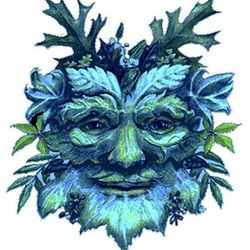Lammas - August 1 This is the traditional first day of autumn. This date, in the middle of the Dog Days of summer, may seem strange if one associates autumn with cooling temperatures and colored leaves, but in an agricultural world, autumn is synonymous with the harvest. In temperate regions of the northern hemisphere, the harvest is in full swing. It is time to can tomatoes, you have more zucchini than you can shake a stick at, and the apples are starting to ripen.
The name Lammas is thought by most to derive from "Loaf Mass". On this day, loaves of bread made from the first of the grain harvest were taken to church as a gift of thanksgiving. After the Anglican Church supplanted the Roman Catholic Church in England, this aspect of the holiday died out, but harvest festivals and fairs have been held at or near this date up until modern times. I find no evidence of Lammas per se being observed in the modern United States.
Halloween - October 31 This is the traditional first day of winter. In temperate regions, the harvest is finished and nothing is growing. Everything is dead. In an  agrarian world, that is winter. With the harvest chores completed and the leaves off of the trees, it was apparently a good time to go hunting. November was also traditionally the time to slaughter pigs, which further linked the time to death.
agrarian world, that is winter. With the harvest chores completed and the leaves off of the trees, it was apparently a good time to go hunting. November was also traditionally the time to slaughter pigs, which further linked the time to death.
In the modern United States, Halloween is the best-known holiday associated with this time, but All Saints Day (November 1) and All Souls Day (November 2) also fall into this time frame. In all of them, the emphasis is on death and those who have died. The ancient Celts observed this as a time associated with darkness and death. It is interesting, though purely co-incidental, that it is around this time of year in the United States that time switches from the later sunset of Daylight Savings Time to the earlier sunset of Standard Time, thus making the long nights seem even longer.
Candlemas - February 2 This is the traditional first day of spring. England is fairly temperate and perhaps things are starting to grow then, but most of the United States is still in the deep freeze. Regardless, people seen to be almost hardwired to feel that by this time, it is time for winter to be over. Perhaps this can help explain the popularity of the  Groundhog Day legend even among modern, educated Americans.
Groundhog Day legend even among modern, educated Americans.
Candlemas Day is one of the Medieval names for this date. It was the day when the priest blessed beeswax candles, which were then distributed to the faithful. Perhaps beeswax, as opposed to any other kind of wax, is a nod to bees as pollinators, and thus, symbolized hope for productive crops. Perhaps the increasing amount of daylight and increasing strength of the sun inspired the originator to think that this would also be a good day to bless the little indoor "suns". Traditionally, there does not seem to be a lot of revelry associated with this day. Perhaps because it was the start of the work year.
February 2 has its share of superstitions and legends attached to it. A few are:
- If there is good weather on Candlemas, there will be 40 more days of winter. If there is bad weather on Candlemas, winter is over.
- Christmas decorations need to be removed by February 1. If any remain on February 2, there will be a death in the household before the year is out.
- Candles blessed on Candlemas may protect a house from lightning strikes.
- Sailors believed that a voyage begun on February 2 would end in disaster.
May Day - May 1 This is the traditional first day of summer. In England, planting was to be finished by this date and farm workers often got the day off. This day was never appropriated by the Church to the degree that the other cross-quarter days were, so  it was a day of secular festivities from the ancient Anglo-Saxon tradition. Some, like morris dancing, the maypole, and crowning of a May queen, survive in England to this day.
it was a day of secular festivities from the ancient Anglo-Saxon tradition. Some, like morris dancing, the maypole, and crowning of a May queen, survive in England to this day.
Aside from perhaps some local traditions, May Day is pretty much a forgotten holiday in the United States. The holiday never had much chance here in the early days because Puritans where opposed to such frivolities. Later settlers from areas with May Day traditions did come to the United States in large numbers, and Puritans were not a force everywhere, but still the holiday never caught on.
May 1 is Labor Day in many countries. At first glance, there does not seem to be a connection between the urban, industrial Labor Day and the rural, agricultural May Day, but there may be a loose connection. May 1 was chosen as the date of the first labor celebration in order to commemorate the Haymarket Riot. However, the riot occurred on May 4. Perhaps May 1 was chosen because it was pre-existing festival for many Europeans, with ties to agricultural labor, and also was close to May 4. The United States chose the first Monday in September for its Labor Day because May 1 was, in American minds, too closely associated with the anarchist movement and communism.
Cross-quarter days are ancient holidays, but they can work for the modern person, too. You could use the dates as reminders. For example, depending on where you live, it might be appropriate to start seeds indoors on February 2, transplant them outdoors on May 1, dig and divide perennials on August 1, and winterize the pond on October 31. You might enjoy starting your own tradition. If you are tired of the cold, look for subtle signs of spring on February 2. If you are tired of the heat, look for signs of autumn on August 1. You can never have too many holidays.
Images are from Les Très Riches Heures du duc de Berry.

















